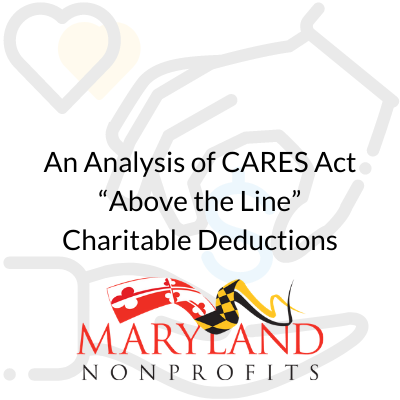An Analysis of CARES Act “Above the Line” Charitable Deduction

The “Coronavirus Aid, Relief and Economic Security” (or “CARES”) Act established what’s called an “above the line” charitable deduction of $300 to stimulate charitable giving in response to the pandemic. As you are considering your charitable giving this year and how to help communities through the crisis, if you are a non-itemizer, this is a great incentive to increase your charitable giving this year.
How is this new “above the line” deduction different from the existing charitable deduction, what “line” is that, and why put this ‘deduction’ above it?
To start – think of the basic steps that go into calculating your tax liability. Conceptually these are:
- adding up gross income,
- applying adjustments (additions or subtractions) to gross income to yield adjusted gross income or “AGI”,
- deducting either ‘itemized’ or the ‘standard’ deductions from AGI to determine net taxable income,
- calculating the tax due on the net taxable income,
- applying any tax credits against that amount of liability,
- deducting taxes already withheld or paid to yield the amount of tax due.
The adjustments that reduce gross income in Step 2 to determine “AGI” are commonly referred to as “above the line”, as opposed to the deductions (including for charitable contributions) that occur after the AGI is calculated, that are considered to be “below the line.” [1] In some tax situations, ‘above the line’ reductions to income can be more advantageous than ‘below the line’ itemized deductions, that are more often subject to caps or limitations.
More importantly in this case, this deduction taken ‘above the line’ benefits taxpayers using the standard deduction. The 2017 tax bill greatly increased the standard deduction, and at the same time capped the amount taxpayers could claim as itemized deductions for their state and local taxes. This combination in the tax bill significantly reduced the number of ‘itemizing’ taxpayers, and appears to have negatively impacted charitable giving nationally.
The purpose of the CARES Act’s $300 charitable ‘deduction’ was to promote charitable giving during the crisis by providing this ‘above the line’ tax incentive to the approximately 90% of all taxpayers who now use the enhanced standard deduction.
The CARES Act provides that the new deduction cannot be used by itemizing taxpayers. All of their contributions must be taken ‘below the line’ as itemized deductions. Further, this benefit is limited to $300 on both individual and joint returns, and only applies to tax year 2020.
[1] on older IRS Forms 1040, the adjusted gross income calculation ended at the bottom of the first page, and that number was then also entered at the top of page 2 to continue calculations
